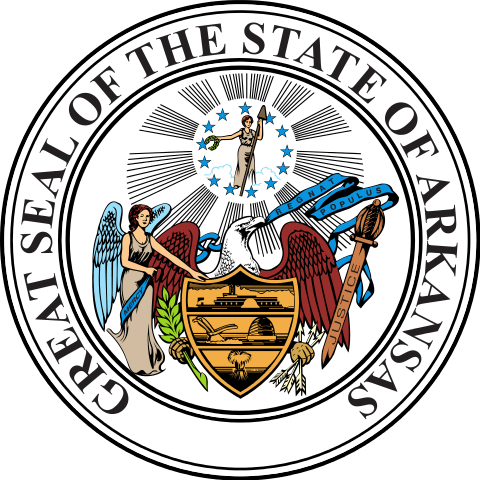Arkansas is one of the southern states of the United States of America. Arkansas’ nicknames are The Natural State and Land of Opportunity. An earlier nickname was “The Bear State”. The capital is Little Rock.
| Area | 137,732 km² |
| Residents | 2,937,979 |
| Residents per km² | 21.3 |
| Capital | Little rock |
| Postal Code | AR |
| ISO-3166-2 code | US AR |
| FIPS code | 05 |
Geography
Arkansas’s eastern border is the Mississippi River, which separates Arkansas from Tennessee and Mississippi. Arkansas is bordered by Louisiana to the south, Texas and Oklahoma to the west, and Missouri to the north.
Arkansas is characterized by mountains, dense forests and fertile plains. Arkansas has a large number of natural caves and has the only natural diamond in the United States near Murfreesboro. The highest point is Mount Magazine in the north of the state at 839 meters.
History
Before European conquerors came to what is now Arkansas, the Quapaw, Caddo and Osage Indians ruled the country. The first European conquerors were the Spaniards in the 16th century and the French in the 17th century. Arkansas was part of the French colony of Louisiana in the 18th century. In 1762 France ceded the territory to Spain, but received it back in 1800. In 1803 Arkansas came to the United States as part of the Louisiana Purchase, and on June 15, 1836, it became the 25th state.
Economy
The GDP was US $ 120.6 billion in 2016, which is approximately 0.65 percent of the total US GDP. The gross domestic product per capita GDP was USD 40,388 in 2016 (average of the 50 US states: USD 57,118; national ranking: 47). The unemployment rate was 3.7% in November 2017 (national average: 4.1%).
The most important branch of the economy is agriculture with the following focuses :
- Cultivation of soybeans, rice, fruits, wheat and cotton
- Poultry farming
- Forestry and wood processing industry
Arkansas has rich natural resources (bauxite, coal, oil, natural gas). The textile and food industries are important.
Sun Belt
Sun Belt is the name for the area south of the 37th latitude of the United States of America. This region has developed into the future region of the American economy in recent years and is experiencing strong population growth. It owes its name to the prevailing climate. The term Sun Belt is also climatically and economically in contrast to the Rust Belt (= rust belt, formerly “Manufacturing Belt”) or Snow Belt (= frost belt).
The Sun Belt includes, for example, Silicon Valley in California, the classic southern states, Florida as well as the area south of the Appalachians and the petroleum industry in Texas. However, one would actually have to rather speak of “sun spots”, since there is no comprehensive development as suggested by the given map or the term. Rather, development is concentrated in a few regions.
The economy in the Sun Belt is supported by six pillars: high technology (electronics, space technology), agribusiness, armaments industry, petrochemicals (oil) as well as real estate and leisure.
The Sun Belt includes Arizona, New Mexico, Texas, Oklahoma, Arkansas, Louisiana, Mississippi, Tennessee, Alabama, Florida, Georgia, South and North Carolina, and the southern portions of Nevada and California.
Also known as The Natural State, Arkansas is short for AR with a population of 2,673,400. The capital city and the biggest city of Arkansas is Little Rock.

